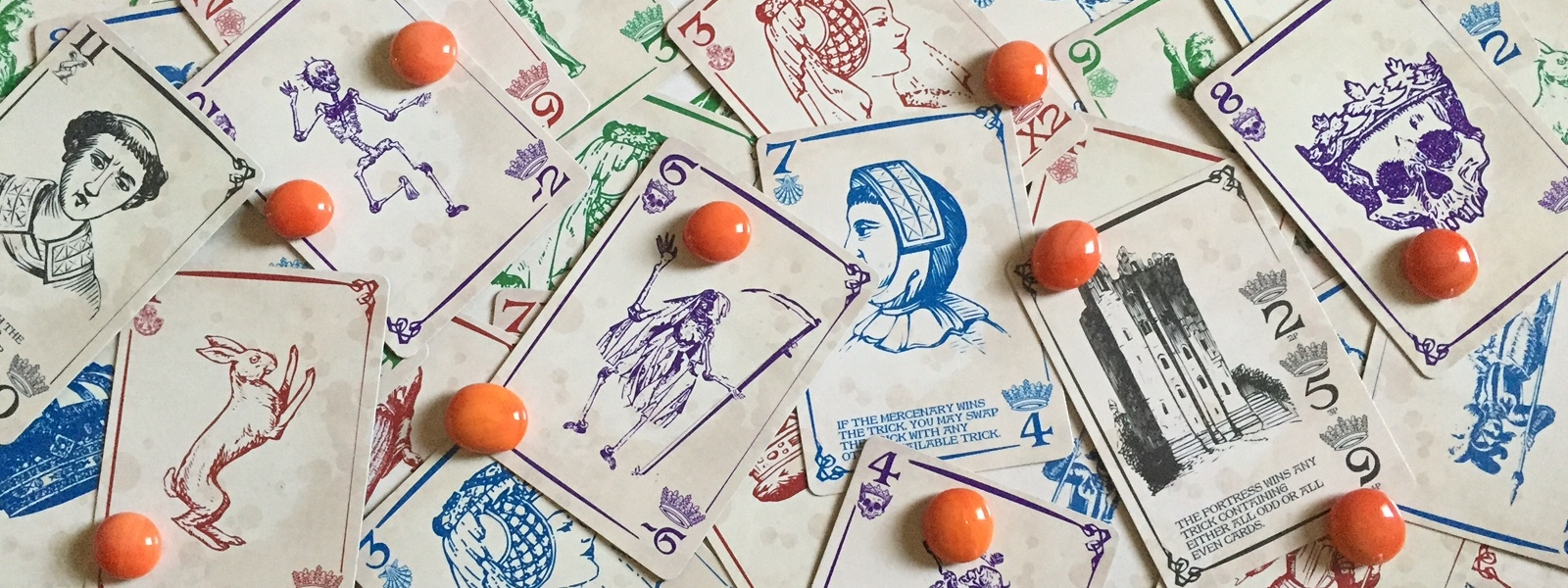
This jam is now over. It ran from 2022-03-17 05:00:00 to 2022-05-10 16:59:59. View 13 entries
"Create a contemporary card-based game that utilizes custom cards that synergize with each other and break the basic flow of rules as a mechanical and strategic necessity."
THEME:
"Metal"
(Your project is required to connect in some way to the above theme in any way you may be inspired to do so.)
100% OPTIONAL Challenges for Inspiration:
"An Heir to Solitaire" - Your entire game is for solo play by a single player. The player interacts with a single deck of cards for the entire game, or the game itself has it's own deck of cards to play against or with the player.
"Party Time. Excellent" - Your game can be played by any number of people at a time. Players can come and go at will without a detriment to the gameplay. It can either be played very quickly or last an entirely indefinite amount of time.
"Bare Handed" - Players can have no more than 2 cards in their hands at any point in time during the game.
Card-based games have an enduring popularity across generations and a special place in contemporary game design. Classic card games rely on a single deck of common, readily available cards that enable a wide range of games to be played with them as a central tool. Known decks like this date back to 9th C China, spreading across the world toward Persia, Arabia, and Egypt. Our western faced French-as-hell cards date back to the 14th C, but all of Europe seems to have their own twist on the design, and even minor deck count changes. Contemporary card games might use the physical structure of a classic playing-card, but require a custom design and deck count designed to be played within specific game rules. Rather than a universal tool enabling play, they are unique components in a closed system of design.
The elephant in the room when discussing modern and contemporary card games is going to be Magic The Gathering. This multi-billion dollar behemoth is a collectible card game requiring players to acquire large sets of multiple cards from random packs in order to access it at all. You’ve likely played it or some form of CCG/TCG in recent times. These (typically) two player games are competitive, intensely strategic, and…expensive as hell to get into, but the longevity of play, artistic quality, and myriad mechanical options keep players in the grind. At the same time we can look to closed-box games such as UNO, Cards Against Humanity, Give Me the Brain, Exploding Kittens, Unstable Unicorns, Dominion, FLUXX and other Target-ready sets that offer up card-based play with unique designs and only a single buy-in. THESE closed-box kits will be our guidance for the project build, while keeping our eyes open to the mechanics of CCG’s. If you make yet another clone of Apples-to-Apples/Cards Against Humanity you will be ridiculed and expected to make an entirely new game on the spot.
We will be making a very non-classic contemporary card game in class as a way to lean into graphic design within the game design space, and learn some key features unique to the contemporary language of game design, namely “synergy/synchronicity” and “rules-breaking”.
Synergy/synchronicity is a fancy way of saying that cards/components in the game function differently when present in the game state together than they might alone. A key element here is that the cards still individually have an effect on the game and can be played or used alone, but have a new unique effect on the flow or play of the game when present together. You game MUST have at least two unique synergy scenarios where two sets of cards create a new effect on the game.
A bigger conversation that pushes the contemporary versus classic card division is that contemporary card games actively break the main gameplay loop or rules using specific cards or components as a key feature of game play. Your main gameplay loop would run something like “draw one card, place one on the table from your hand, resolve its effects, discard a card, next player goes”. This loop happens, theoretically, the same way every single turn as the “rules of action”. “Rules of clarification” or forbidden actions may be “players can only play one card per turn”, “players can only have 5 cards in their hand”, or “a player can only have a maximum of 10 (of some resource)”. In contemporary card games, unique, individual cards may alter this basic flow of order, temporarily or permanently alter a forbidden action, or allow a player to do something entirely unspecified in the basic rules. One of the absolute best ways to see this happen in a game is to play FLUXX. In FLUXX the game objective itself changes through the cards being played, and rules fundamentally shift at a moment's notice. Your game MUST engage in some fashion of rules-breaking during gameplay.
The internal complexity of a contemporary card game, and any hope at “balancing” it for play, is exponentially more difficult than anything we have approached so far. You are strongly advised to work in pairs to split the challenge of design and production up between partners and to be able to actively engage in testing during development.
CLARITY OF ABSOLUTE REQUIREMENTS:
- Primary mechanics and interaction method of gameplay must be based around the use of a deck or collection of unique cards around a common gameplay loop.
- Cards must be entirely designed for this specific game and cannot be extracted from another game set, or standard playing cards.
- There must be at least 25 unique cards used for gameplay.
- At least 2 sets (4 cards) must engage in some form of synergy/synchronistic gameplay. Each card individually has a standard effect on the game, but when in play with it’s mate, create a new unique effect.
- At least 5 cards must take advantage of rules-breaking during gameplay. When these cards are in play some alteration to the main gameplay loop or general rules must take place.
Our same general outline of a game jam applies here: Day 1 you'll receive the conceptual theme on itch.io, along with three optional special challenges you can undertake. We'll engage in collective brainstorming and start to build our games.
Day 2 will be discussion focused, using your games as the starting points. After our discussion you'll be given open development time.
On Day 3 we will head to the Criss Library for a workshop about using Adobe Illustrator for the preparation of cards connected to your game, and preparing those visuals as documents intended for printing and cutting. This will be a key skill for all remaining projects, especially the final.
Day 4 will focus on play testing and finalization of all game elements in preparation for upload to itch.io and the submission of Necessary Game Documents to canvas.
Final documents necessary for each game:
- 1 x Game Breakdown v3.1 (only a pdf will be accepted)
- 1 x Synergy and Rules-Alteration Breakdown (only a pdf will be accepted)
- 1 x Ruleset and Components Documents (pdf)
- 4 x Playtesting Forms (minimum 1 of v2 full scope by each designer, and any number of microsheets by anyone) (pdf, scanned or digital)
Submissions(13)
No submissions match your filter













